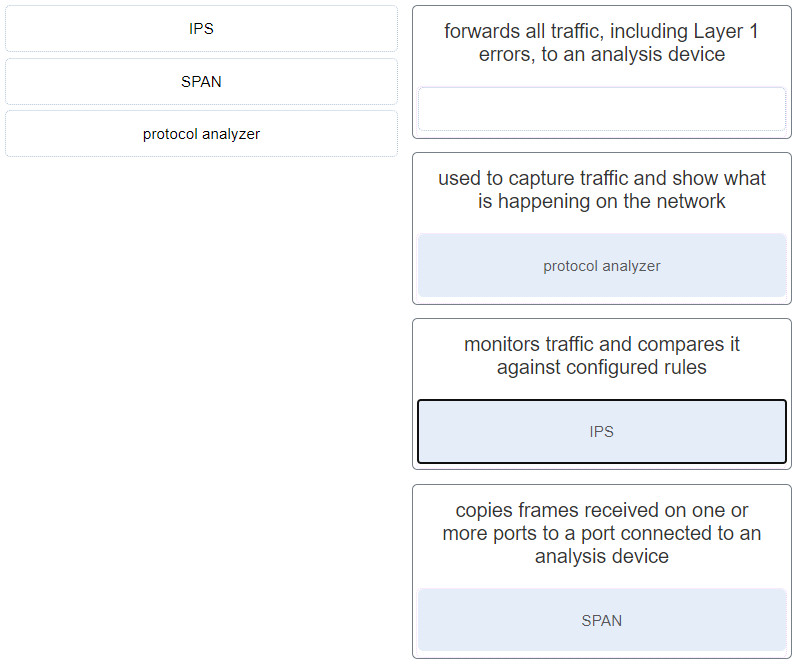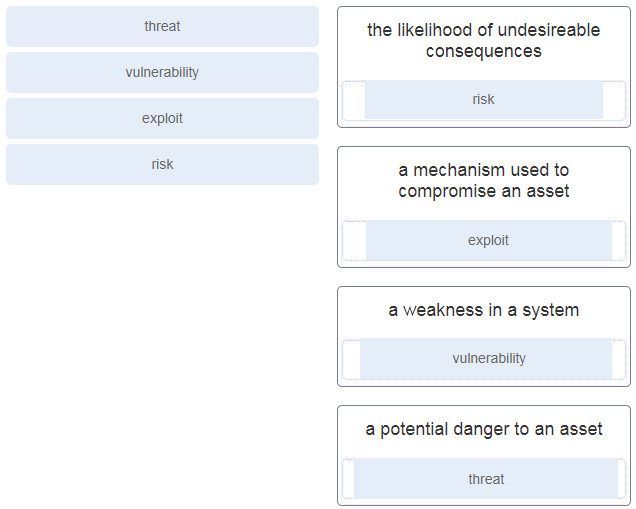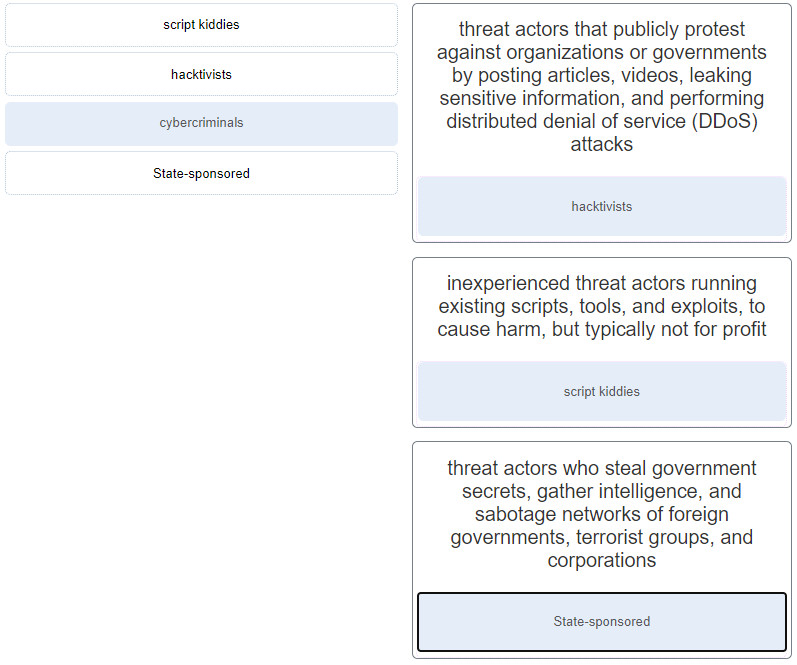CyberOps Associate (Version 1.0) – Modules 13 – 17: Threats and Attacks Group Exam
CyberOps Associate (Version 1.0) – Modules 13 – 17: Threats and Attacks Group Exam
1. Which is an example of social engineering?
- an unidentified person claiming to be a technician collecting user information from employees
- the infection of a computer by a virus carried by a Trojan
- an anonymous programmer directing a DDoS attack on a data center
- a computer displaying unauthorized pop-ups and adware
2. What is a significant characteristic of virus malware?
- A virus is triggered by an event on the host system.
- Virus malware is only distributed over the Internet.
- A virus can execute independently of the host system.
- Once installed on a host system, a virus will automatically propagate itself to other systems.
3. Which access attack method involves a software program that attempts to discover a system password by the use of an electronic dictionary?
- brute-force attack
- IP spoofing attack
- denial of service attack
- port redirection attack
- buffer overflow attack
- packet sniffer attack
4. Which statement describes an operational characteristic of NetFlow?
- NetFlow collects basic information about the packet flow, not the flow data itself.
- NetFlow captures the entire contents of a packet.
- NetFlow flow records can be viewed by the tcpdump tool.
- NetFlow can provide services for user access control.
5. Match the network monitoring solution with a description. (Not all options are used.)

6. Which technology is a proprietary SIEM system?
- StealthWatch
- NetFlow collector
- SNMP agent
- Splunk
7. What are three functionalities provided by SOAR? (Choose three.)
- It automates complex incident response procedures and investigations.
- It provides 24×7 statistics on packets that flow through a Cisco router or multilayer switch.
- It uses artificial intelligence to detect incidents and aid in incident analysis and response.
- It presents the correlated and aggregated event data in real-time monitoring and long-term summaries.
- It provides a complete audit trail of basic information about every IP flow forwarded on a device.
- It provides case management tools that allow cybersecurity personnel to research and investigate incidents.
8. Which devices should be secured to mitigate against MAC address spoofing attacks?
- Layer 7 devices
- Layer 4 devices
- Layer 3 devices
- Layer 2 devices
9. A network administrator is checking the system logs and notices unusual connectivity tests to multiple well-known ports on a server. What kind of potential network attack could this indicate?
- access
- denial of service
- information theft
- reconnaissance
10. What is a vulnerability that allows criminals to inject scripts into web pages viewed by users?
- Cross-site scripting
- XML injection
- buffer overflow
- SQL injection
11. Why would a rootkit be used by a hacker?
- to try to guess a password
- to reverse engineer binary files
- to gain access to a device without being detected
- to do reconnaissance
12. What causes a buffer overflow?
- sending too much information to two or more interfaces of the same device, thereby causing dropped packets
- attempting to write more data to a memory location than that location can hold
- sending repeated connections such as Telnet to a particular device, thus denying other data sources
- downloading and installing too many software updates at one time
- launching a security countermeasure to mitigate a Trojan horse
13. Which type of security threat would be responsible if a spreadsheet add-on disables the local software firewall?
- DoS
- Trojan horse
- buffer overflow
- brute-force attack
14. Which two types of hackers are typically classified as grey hat hackers? (Choose two.)
- hacktivists
- cyber criminals
- vulnerability brokers
- script kiddies
- state-sponsored hackers
15. A white hat hacker is using a security tool called Skipfish to discover the vulnerabilities of a computer system. What type of tool is this?
- debugger
- fuzzer
- vulnerability scanner
- packet sniffer
16. Which two functions are provided by NetFlow? (Choose two.)
- It uses artificial intelligence to detect incidents and aid in incident analysis and response.
- It provides a complete audit trail of basic information about every IP flow forwarded on a device.
- It provides 24×7 statistics on packets that flow through a Cisco router or multilayer switch.
- It allows an administrator to capture real-time network traffic and analyze the entire contents of packets.
- It presents correlated and aggregated event data in real-time monitoring and long-term summaries.
17. Which statement describes the function of the SPAN tool used in a Cisco switch?
- It is a secure channel for a switch to send logging to a syslog server.
- It provides interconnection between VLANs over multiple switches.
- It supports the SNMP trap operation on a switch.
- It copies the traffic from one switch port and sends it to another switch port that is connected to a monitoring device.
18. What are two evasion methods used by hackers? (Choose two.)
- scanning
- access attack
- resource exhaustion
- phishing
- encryption
19. Which attack involves threat actors positioning themselves between a source and destination with the intent of transparently monitoring, capturing, and controlling the communication?
- man-in-the-middle attack
- DoS attack
- ICMP attack
- SYN flood attack
20. What is the goal of a white hat hacker?
- validating data
- modifying data
- stealing data
- protecting data
21. Once a cyber threat has been verified, the US Cybersecurity Infrastructure and Security Agency (CISA) automatically shares the cybersecurity information with public and private organizations. What is this automated system called?
- AIS
- NCSA
- ENISA
- NCASM
22. A user receives a phone call from a person who claims to represent IT services and then asks that user for confirmation of username and password for auditing purposes. Which security threat does this phone call represent?
- spam
- anonymous keylogging
- DDoS
- social engineering
23. Which two characteristics describe a worm? (Chose two)
- is self-replicating
- travels to new computers without any intervention or knowledge of the user
- infects computers by attaching to software code
- hides in a dormant state until needed by an attacker
- executes when software is run on a computer
24. What kind of ICMP message can be used by threat actors to create a man-in-the-middle attack?
- ICMP echo request
- ICMP unreachable
- ICMP redirects
- ICMP mask reply
ICMP echo request and echo reply: used to perform host verification and DoS attacks
ICMP unreachable: used to perform network reconnaissance and scanning attacks
ICMP mask reply: used to map an internal IP network
ICMP redirects: used to lure a target host into sending all traffic through a compromised device and create a man-in-the-middle attack
ICMP router discovery: used to inject bogus route entries into the routing table of a target host
25. What are two purposes of launching a reconnaissance attack on a network? (Choose two.)
- to escalate access privileges
- to prevent other users from accessing the system
- to scan for accessibility
- to gather information about the network and devices
- to retrieve and modify data
26. Which type of network attack involves randomly opening many Telnet requests to a router and results in a valid network administrator not being able to access the device?
- DNS poisoning
- man-in-the-middle
- SYN flooding
- spoofing
27. What functionality is provided by Cisco SPAN in a switched network?
- It mirrors traffic that passes through a switch port or VLAN to another port for traffic analysis.
- It prevents traffic on a LAN from being disrupted by a broadcast storm.
- It protects the switched network from receiving BPDUs on ports that should not be receiving them.
- It copies traffic that passes through a switch interface and sends the data directly to a syslog or SNMP server for analysis.
- It inspects voice protocols to ensure that SIP, SCCP, H.323, and MGCP requests conform to voice standards.
- It mitigates MAC address overflow attacks.
28. An attacker is redirecting traffic to a false default gateway in an attempt to intercept the data traffic of a switched network. What type of attack could achieve this?
- MAC address snoopin
- DHCP snooping
- MAC address starvation
- DHCP spoofing
29. What would be the target of an SQL injection attack?
- DHCP
- DNS
- database
30. The IT department is reporting that a company web server is receiving an abnormally high number of web page requests from different locations simultaneously. Which type of security attack is occurring?
- social engineering
- adware
- DDoS
- phishing
- spyware
31. Why would an attacker want to spoof a MAC address?
- so that the attacker can capture traffic from multiple VLANs rather than from just the VLAN that is assigned to the port to which the attacker device is attached
- so that a switch on the LAN will start forwarding frames to the attacker instead of to the legitimate host
- so that a switch on the LAN will start forwarding all frames toward the device that is under control of the attacker (that can then capture the LAN traffic)
- so that the attacker can launch another type of attack in order to gain access to the switch
32. Match the security concept to the description.

33. What is the significant characteristic of worm malware?
- Worm malware disguises itself as legitimate software.
- Once installed on a host system, a worm does not replicate itself.
- A worm must be triggered by an event on the host system.
- A worm can execute independently of the host system.
34. What are the three major components of a worm attack? (Choose three.)
- a payload
- a propagation mechanism
- an infecting vulnerability
- a probing mechanism
- an enabling vulnerability
- a penetration mechanism
35. A user is curious about how someone might know a computer has been infected with malware. What are two common malware behaviors? (Choose two.)
- The computer emits a hissing sound every time the pencil sharpener is used.
- The computer beeps once during the boot process.
- The computer gets increasingly slower to respond.
- No sound emits when an audio CD is played.
- The computer freezes and requires reboots.
Appearance of files, applications, or desktop icons
Security tools such as antivirus software or firewalls turned off or changed
System crashes
Emails spontaneously sent to others
Modified or missing files
Slow system or browser response
Unfamiliar processes or services running
Unknown TCP or UDP ports open
Connections made to unknown remote devices
36. Which two types of attacks are examples of reconnaissance attacks? (Choose two.)
- brute force
- port scan
- ping sweep
- man-in-the-middle
- SYN flood
37. An administrator discovers a vulnerability in the network. On analysis of the vulnerability the administrator decides the cost of managing the risk outweighs the cost of the risk itself. The risk is accepted, and no action is taken. What risk management strategy has been adopted?
- risk transfer
- risk acceptance
- risk reduction
- risk avoidance
38. Which protocol is exploited by cybercriminals who create malicious iFrames?
- HTTP
- DNS
- ARP
- DHCP
39. How can a DNS tunneling attack be mitigated?
- by preventing devices from using gratuitous ARP
- by using a filter that inspects DNS traffic
- by securing all domain owner accounts
- by using strong passwords and two-factor authentication
40. What is the function of a gratuitous ARP sent by a networked device when it boots up?
- to request the netbios name of the connected system
- to request the MAC address of the DNS server
- to request the IP address of the connected network
- to advise connected devices of its MAC address
41. What is the result of a passive ARP poisoning attack?
- Data is modified in transit or malicious data is inserted in transit.
- Network clients experience a denial of service.
- Confidential information is stolen.
- Multiple subdomains are created.
42. What are two methods used by cybercriminals to mask DNS attacks? (Choose two.)
- reflection
- shadowing
- domain generation algorithms
- fast flux
- tunneling
43. Match the security tool with the description. (Not all options apply.)

44. Match the type of cyberattackers to the description. (Not all options are used.)

45. Match the threat actors with the descriptions. (Not all options are used.)

- hacktivists : threat actors that publicly protest against organizations or governments by posting articles, videos, leaking sensitive information, and performing distributed denial of service (DDoS) attacks
- script kiddies : inexperienced threat actors running existing scripts, tools, and exploits, to cause harm, but typically not for profit
- State-sponsored : threat actors who steal government secrets, gather intelligence, and sabotage networks of foreign governments, terrorist groups, and corporations
46. What scenario describes a vulnerability broker?
- a teenager running existing scripts, tools, and exploits, to cause harm, but typically not for profit
- a threat actor attempting to discover exploits and report them to vendors, sometimes for prizes or rewards
- a threat actor publicly protesting against governments by posting articles and leaking sensitive information
- a State-Sponsored threat actor who steals government secrets and sabotages networks of foreign governments
47. In what type of attack is a cybercriminal attempting to prevent legitimate users from accessing network services?
- DoS
- session hijacking
- MITM
- address spoofing
16. Which field in the IPv6 header points to optional network layer information that is carried in the IPv6 packet?
- traffic class
- version
- flow label
- next header
48. Which type of attack is carried out by threat actors against a network to determine which IP addresses, protocols, and ports are allowed by ACLs?
- social engineering
- denial of service
- phishing
- reconnaissance
49. Which cyber attack involves a coordinated attack from a botnet of zombie computers?
- ICMP redirect
- MITM
- DDoS
- address spoofing
50. What technique is a security attack that depletes the pool of IP addresses available for legitimate hosts?
- reconnaissance attack
- DHCP starvation
- DHCP spoofing
- DHCP snooping
51 Which type of Trojan horse security breach uses the computer of the victim as the source device to launch other attacks?
- proxy
- FTP
- DoS
- data-sending
52. What are two examples of DoS attacks? (Choose two.)
- buffer overflow
- SQL injection
- port scanning
- phishing
- ping of death
